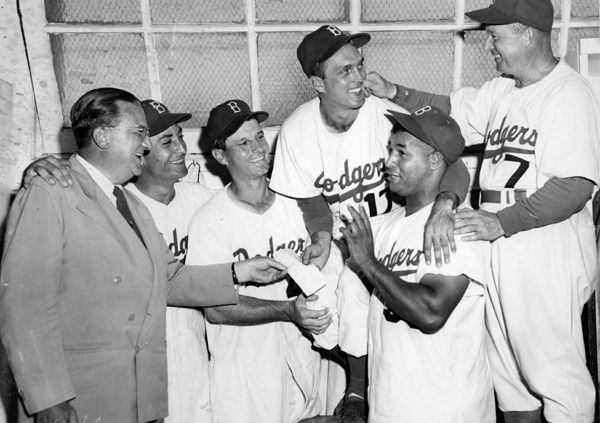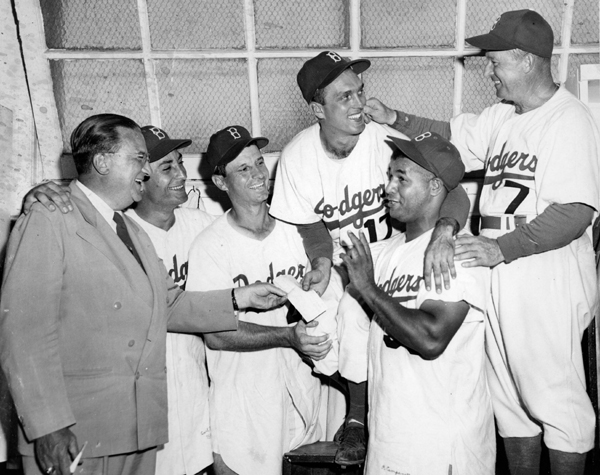June 19, 1952: Dodgers’ Carl Erskine tosses his first no-hitter
Walter O’Malley, president of the Dodgers, gives Carl Erskine a $500 check for tossing a no-hitter. Also celebrating are (L-R) Carl Furillo, Preacher Roe, Roy Campanella, and skipper Charlie Dressen. (Photo: SABR-Rucker Archive)
Some wondered if the game would even start. It was a hot, muggy Thursday afternoon in Brooklyn with temperatures in the mid-80s and rain on the way.1 The skies were dark and the lights were on at Ebbets Field by the 1:30 game time. When the clouds finally burst open at 2:10, a torrential rainfall with high winds interrupted the game, and the prospect of resuming play did not appear good.
The Dodgers were rolling over their competition. Skipper Chuck Dressen’s squad had the best record in baseball (39-15) and a four-game lead over the New York Giants as they prepared to conclude a three-game series with the Chicago Cubs as part of a 19-game homestand broken up by a sole game in the Polo Grounds. As expected, the club’s high-powered offense was lighting up the scoreboard; however, its pitching staff proved much stronger than anticipated. Given the loss of ace Don Newcombe, serving in the military, Dressen relied on a group of relatively inexperienced hurlers.
One member of that “Kiddie Corps” was 25-year-old Carl Erskine, a 5-foot-10, 160-pound right-hander. On a team with big personalities, Erskine was unassuming and good-natured, and neither smoked nor drank. “His gentle expression, rosy complexion and general demeanor,” opined sportswriter Lorin McMullen, “doubtless caused more than one of his managers to think that he was entirely too nice to make the grade in the rough, tough, dog-eat-dog world that is baseball.”2 Erskine emerged in his fourth season, in 1951, as a dependable swingman, going 16-12 and logging 189⅔ innings. Still battling inconsistencies thus far in ‘52 (such as tossing his first shutout and also getting bombed in starting and relief assignments), Erskine was 5-1 and 42-23 in his career.
Despite the ominous weather forecast, the Dodgers-Cubs matchup drew a crowd of 13,232 to Flatbush, including an estimated 5,000 knotholers and 500 blind guests.3 The Cubs were one of the feel-good stories thus far in baseball. Following a last-place finish a year earlier, player-manager Phil Cavarretta’s team was in third place (34-23), but on this day was riding a four-game losing streak.
After Erskine breezed through a one-two-three first, the Dodgers took their whacks against Cubs starter Warren Hacker. Biding his time between the minors and the big-league club in the previous four seasons, the 27-year-old right-hander finally caught on in ‘52. He was coming off two stellar complete-game victories to push his record to 4-1 with a robust 2.68 ERA. Pee Wee Reese got things started by smashing a one-out grounder that took a bad hop, according to the New York Times, over shortstop Eddie Miksis’s shoulder.4 After Jackie Robinson popped up, Reese stole second and advanced to third on catcher Toby Atwell’s poor throw, then sauntered home when Roy Campanella parked his ninth home run in the lower left-center seats for a 2-0 Dodgers lead. Carl Furillo followed by spanking his sixth home run, which landed in almost the same spot. The Dodgers made it 4-0 on Andy Pafko’s solo shot, his 10th round-tripper of the season, with one out in the second. That one sent Hacker to the showers.
Staked to an early lead and seeing the clouds darken, Erskine worked quickly, not wanting to waste his teammates’ three round-trippers should the game be called. He dispatched the Cubs in order in the second, and the first two batters in the third. Then Erskine had a hiccup, walking reliever Willie Ramsdell on four straight pitches. “I was in a hurry to get the side out, as the rain was coming,” said Erskine. “I was anxious to hurry it up so it would be a legal game. I kept firing balls to Ramsdell and couldn’t get one over.”5 Erskine’s bugaboo was his control and one of the reasons he had not yet fully established himself as a starter. Nonetheless, he seemed embarrassed by walking a pitcher, a former Dodger whom he described as “the only man who couldn’t hit the ball out of the park if I’d teed it up for him.”6 Miksis followed with a rifle smash that looked as if it would fall for a hit, but left fielder Andy Pafko raced over to snare it on the run. Unbeknownst at the time, Pafko’s catch was the first of several stellar plays that helped Erskine make history.
A furious thunderstorm erupted at the top of the fourth, sending players and spectators running for cover. According to the Brooklyn Eagle, the Dodgers’ grounds crew, led by Eddie Durham, had the infield covered in record time: 1 minute and 20 seconds.7 Vicious winds swept the park; sportswriter Roscoe McGowen described them as a “twister” that forced the grounds crew to sit on top of the infield tarpaulin to keep it from flying away.8
After a 44-minute delay, home-plate umpire Jocko Conlan resumed the game. “I didn’t mind the long wait,” said Erskine. “I threw six or seven warm-up balls when we got back and seemed to still have my stuff.” Erskine made quick work in the fourth, retiring the side on three straight grounders.9
Erskine was known to have one of the league’s best changeups, but discarded it early in this contest, in favor of his fastballs, curves, and sliders. “I was getting ‘em out,” he quipped, “so I didn’t have to use my change of pace except once.”10
The Cubs pounded Erskine’s breaking ball into the dirt all afternoon which resulted in some slick fielding. With one out in the fifth, Dee Fondy hit a sharp ball back to the mound. Cubs beat writer Irving Vaughan described it as a “cinch hit into dead center,”11 while Erskine said “it was a do-or-don’t play.”12 Instinctively Erskine reached out with his glove hand and made a clean stop and then perfect throw to first for the out. In the sixth, third baseman Bobby Morgan charged Ramsdell’s slow chopper and threw to an outstretched Gil Hodges at first in one of the closest plays of the game. The Cubs hit only five balls out of the outfield. NL home run leader (and eventual MVP) Hank Sauer connected for the hardest shots, but right fielder Carl Furillo had it perfectly played and caught it against the scoreboard.
Since replacing Hacker with one out in the second, Ramsdell had shut down the Dodgers’ vaunted offense, which eventually led the NL in scoring for the fourth straight season. He retired 17 of 18 batters, yielding only a bunt single to Pafko in the fifth. Dem Bums finally got to the 36-year-old knuckleballer with two outs in the eighth. Reese singled and stole second, then Robinson walked. Campanella’s single gave the Dodgers a 5-0 lead.
Erskine entered the ninth just three outs away from his first no-hitter since his high-school days. He also knew a no-hitter could end instantly, and shutouts, too. In the previous summer he retired 21 straight Cincinnati Reds on July 16 at Ebbets Field, only to yield a leadoff single in the eighth to Ted Kluszewski and then lost the shutout three batters later on Virgil Stallcup’s two-run home run.
On the other hand, the gods of no-hitters were on the Dodgers’ side that June week in 1952. Just two days earlier, two Class D Dodger farmhands twirled no-nos. Anthony Develis of Ponca City (Oklahoma) held Iola hitless and fanned 16 in the Kansas-Oklahoma-Missouri League; Valdosta’s Don Terwedow was less spectacular in his seven-walk no-hitter against Moultrie (Georgia) in the Georgia-Florida-League.13 (Neither of those prospects ever reached the majors.)
Erskine retired Bob Ramazzotti on a grounder that third baseman Morgan charged and threw precisely for the first out of the ninth. Erskine “had a good slider, and a good curve, and a live fast ball that hopped, but we even gave up on that fast ball in the ninth inning,” said catcher Roy Campanella. “Didn’t want to take a chance with it, even though he was behind on the hitters. We gave ‘em sliders and curves.”14 Left-handed-hitting Cavaretta, calling on himself to pinch-hit for Ramsdell, sent a hard smash deep into the right-field stands. The crowd took a collective gasp, but the ball was foul.15 Erskine dispatched him on a high popup to center fielder Duke Snider. On a 3-and-2 count, Miksis, another former Dodger, grounded to Reese, whose throw to Hodges ended the game in 1 hour and 48 minutes to secure Erskine’s no-hitter.
Except for his walk to Ramsdell, Erskine was in control throughout the game, tossing 103 pitches, including 63 strikes. It was the first no-hitter against the Cubs since Fred Toney engaged Hippo Vaughan in an epic hitless duel through nine innings on May 2, 1917, at Weeghman Park (later known as Wrigley Field) and completed the no-hitter in 10 frames. Erskine’s gem was the first Dodgers no-hitter since Rex Barney’s against the Giants at the Polo Grounds on September 9, 1948 and the first Dodgers no-hitter at Ebbets Field since Ed Head’s against the Boston Braves on April 23, 1946. Erskine would also author the Dodgers’ next no-hitter, on May 12, 1956, against the Giants at Ebbets Field.
SOURCES
In addition to the sources cited in the Notes, the author accessed Retrosheet.org, Baseball-Reference.com, SABR.org, and The Sporting News archive via Paper of Record.
NOTES
1 “Daily Almanac,” New York Daily News, June 20, 1952: 2.
2 Lorin McMullen, “Erskine Shows What Nice Guys Can Do,” Fort Worth Star-Telegram, June 20, 1952: 15.
3 Harold Burr, “It’s Picnic Times for the Erskine Family,” Brooklyn Eagle, June 20, 1952: 14.
4 Roscoe McGowen, “Erskine Hurls No-Hitter and Misses Perfect Game by One Walk,” New York Times, June 20, 1952: 28.
5 Burr.
6 Dick Young, “Erskine No-Hits Cubs, 5-0; Walk Costs Perfect Game,” New York Daily News, June 20, 1952: 64.
7 “Hitless Effort Earns Erskine Bonus,” Brooklyn Eagle, June 20, 1952: 14.
8 McGowen.
9 Burr.
10 Burr.
11 Irving Vaughan, “Dodgers’ Erskine Holds Cubs Hitless, 5-0,” Chicago Tribune, June 20 1952: 37.
12 McGowen.
13 Bob Gould, “No-Hitters Turned In by 2 Farmhands,” Brooklyn Eagle, June 19, 1952: 17.
14 Young.
15 McGowen.
Additional Stats
Brooklyn Dodgers 5
Chicago Cubs 0
Ebbets Field
Brooklyn, NY
Box Score + PBP:
Corrections? Additions?
If you can help us improve this game story, contact us.



